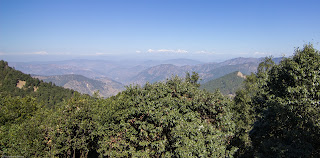After facing quite a lot of criticism over the previous design, I made sure that I covered all the shortcomings of the previous design and created this one. This is my 4th T Shirt design, so now I roughly know how to approach and what to expect it in its final output. Knowledge of Corel Draw is recommended coz the final design is made in Corel Draw. Even if you don't (like me!), you can create your design in Photoshop/Paint Shop Pro and hand over the design to the printer. Make sure you follow these basic things while designing:
- Mind your colors: remember that you have only limited color palettes at your disposal. Shades of similar color might not get printed exactly the way you want it to be. So use contrasting and bright colors for your designs. Also the printer would charge you additional cost for every color you use in your prints (irrespective of the print area of that color). So I would suggest you to limit the use of colors in your design to 1 or 2 colors and use them in a contrasting manner to get the best look for your design.
- Make a big picture: If your design has plenty of graphics, make sure your file dimension is big enough so that you get best resolution while printing. For example: 4000x4000 pixels @ 200dpi would give you a good sharp output without any need for upsampling your image.
- T shirt color: Always the first thing to consider while designing is the color of the T shirt coz it would act as the background color for your design. Though you can choose a Shirt of any color which is available in the market, but if you're confused over the best color to select, then better go for white, grey or black. They are the universal colors and by universal I mean they're the best for all practical purposes and suits on all skin tones.
- Positioning of your design: Make sure you place your main subject/highlight to the 'chest' (thats coz people have this tendency to place the design at the tummy, never do it.)
However these are just some guidelines and the final look you your shirt would depend on your sense of design and etiquette. If you have any queries or suggestions, feel free to express your thoughts here itself or mail me at jishnuclicks@gmail.com



















